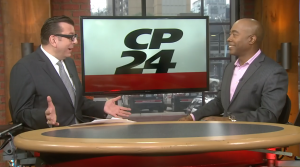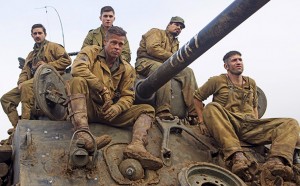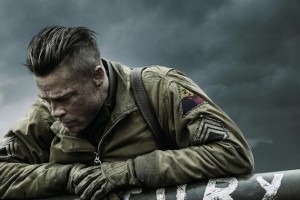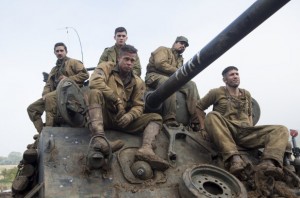RICHARD’S WEEKEND MOVIE REVIEWS FROM CP24! FRIDAY OCTOBER 17, 2014.
 CP24 film critic Richard Crouse reviews the weekend’s biggest releases, including “Book of Life,” “Fury” and “St. Vincent.”
CP24 film critic Richard Crouse reviews the weekend’s biggest releases, including “Book of Life,” “Fury” and “St. Vincent.”
Watch the whole thing HERE!
 CP24 film critic Richard Crouse reviews the weekend’s biggest releases, including “Book of Life,” “Fury” and “St. Vincent.”
CP24 film critic Richard Crouse reviews the weekend’s biggest releases, including “Book of Life,” “Fury” and “St. Vincent.”
Watch the whole thing HERE!
 Richard’s “Canada AM” reviews for “Fury,” (or “Everything You Ever Wanted to Know About Tanks But Where Afraid to Ask!”) “Book of Life” and “St. Vincent.”
Richard’s “Canada AM” reviews for “Fury,” (or “Everything You Ever Wanted to Know About Tanks But Where Afraid to Ask!”) “Book of Life” and “St. Vincent.”
Watch the whole thing HERE!
 “Fury” is a brutal war film with exciting and well-executed battle sequences, but its most vicious scene takes place over a meal, at a table set with a lace tablecloth.
“Fury” is a brutal war film with exciting and well-executed battle sequences, but its most vicious scene takes place over a meal, at a table set with a lace tablecloth.
Set in April 1945, the movie sees hard-bitten commander “Wardaddy” Collier (Brad Pitt) lead a U.S. 2nd armored division tank nicknamed Fury through Germany in the final days of World War II. His crew, “Bible” Swan (Shia LaBeouf, once again acting opposite giant machines), Gordo (Michael Peña) and redneck Grady (Jon Bernthal), have fought together since the beginning of the war. When Norman Ellison (Logan Lerman), a new gunner recruit with no battle experience, signs on, he must fit in or endanger the entire crew. “You are no use to me if you can’t kill krauts,” says Wardaddy.
Body parts fly, tanks try to out maneuver one another and the cost of the fake body parts that litter the battlefield must have rivaled Pitt’s salary but the scene that keeps “Fury” from becoming Das Boot on land happens midway in the film after the crew has captured a German town. Once the bullets stop flying two local women prepare a meal for Wardaddy and Norman. The long scene begins with tension as the German ladies try and figure out if the Nazi hunters mean them harm but when the core group crowds around the table it becomes something akin to a surreal family dinner where real humanity, or lack thereof, is laid bare. It could have stopped the movie dead in its tracks, but instead is a welcome interlude that showcases the effects of battle on a tightly knit but disparate group of men.
It’s a stunner of a scene that breaks up the relentless grimness of the action. The gruesome sights of war—bodies on the battlefield and even a close-up of part of a man’s face in the tank cab—are on ample display but I was fascinated by the tank interiors. A sense of claustrophobia, tension and fear percolates inside the tiny spaces and literally bleeds off the screen. It helps that the performances are very strong, but it’s the primal feeling of being trapped inside the small cab that gives the movie much of it oomph.
As the leader of the crew Pitt does a good job of leading the cast. He could easily have done a rehash of his Nazi hunting character from Inglourious Basterds, but there are subtle differences. That character was over-the-top, and so is this one; much of his dialogue sounds like it was written by Quentin Tarantino, but the character is deeper, not so much in what he says, but in his quiet scenes when everything you need to know about him is written on his face.
Lerman brings a conflicted sensitivity to a role of a young man thrust into a situation beyond his control and understanding, and Bernthal takes another step towards becoming a go-to character actor, but the actors must constantly compete with the tanks to get noticed.
On the battlefield “Fury” is tank porn. The action scenes are certainly exciting, but it is the quieter moments where the movie makes the point that War is Hell no matter what side you are on.
 By Richard Crouse & Mark Breslin
By Richard Crouse & Mark Breslin
Synopsis: Set in April 1945, the movie sees hard-bitten commander “Wardaddy” Collier (Brad Pitt) lead a U.S. 2nd armored division tank nicknamed Fury through Germany in the final days of World War II. His crew, “Bible” Swan (Shia LaBeouf, once again acting opposite giant machines), Gordo (Michael Peña) and redneck Grady (Jon Bernthal), have fought together since the beginning of the war. When Norman Ellison (Logan Lerman), a new gunner recruit with no battle experience, signs on, he must fit in or endanger the entire crew. “You are no use to me if you can’t kill krauts,” says Wardaddy.
Star Ratings:
Richard: 4 Stars
Mark: 4 Stars
Richard: Mark, Fury is a brutal war film with exciting and well-executed battle sequences, but its most vicious scene takes place over a meal, at a table set with a lace tablecloth. It happens midway in the film after the crew has captured a German town. Once the bullets stop flying two local women prepare a meal for Wardaddy and Norman. The long scene begins with tension as the German ladies try and figure out if the Nazi hunters mean them harm but when the core group crowds around the table it becomes something akin to a surreal family dinner where real humanity, or lack thereof, is laid bare. It could have stopped the movie dead in its tracks, but instead is a welcome interlude that showcases the effects of battle on a tightly knit but disparate group of men.
Mark: Yes, Richard, it’s an excruciating scene, and I mean that in the best way. What I liked about it was the way it disposed of the “greatest generation” mythology and showed American soldiers as borderline rapists and sadists. Not Pitt, of course, who is just and fair, but some of the soldiers who saved us from the Nazis were swine themselves. It is a depressing irony in a film that’s too tough for irony. I admired the general toughness of the movie; war is not glamourized, it’s shown to be a cesspool of degradation, a literal mud bath. I can’t even imagine what the mud budget was for the picture.
RC: The mud budget and the cost of the fake body parts that litter the battlefield must have rivalled Pitt’s salary. Those are the details, however, that give the movie so much of its grit. The dinner scene helps open the movie up and keep it from becoming Das Boot on land, but I was fascinated by the tank interiors. A sense of claustrophobia, tension and fear percolates inside the tank cab and literally bleeds off the screen. It helps that the performances are very strong, but it’s the primal feeling of being trapped inside the small space that gives the movie much of it oomph.
MB: Yes, I couldn’t get into the elevator after I saw the film. The performances are strong, as you say, and I was most impressed by Shia LaBoeuf, who we can now all forgive for all those Transformers movies. Michael Pena is great, but he’s always great. A real surprise is Jon Bernthal, a relative newcomer, who nails his southern-fried redneck character as a man you equally hate and pity. And what did you think of Pitt, Richard?
RC: Pitt really pulls this off. At first I was concerned he was going to hand in a rehash of his Nazi hunting character from Inglourious Basterds. That character was over-the-top, and so is this one in his own way. Much of his dialogue sounds like it was written by Quentin Tarantino, but the character is deeper, not so much in what he says, but in his quiet scenes when everything you need to know about him is written on his face.
MB: The sadness is even in his haircut, which has its own gravitational pull.
 By Richard Crouse – Metro Canada
By Richard Crouse – Metro Canada
Fury, the new Second World War film starring Brad Pitt and Shia LaBeouf, is being called the most realistic war film of all time. The story of a U.S. 2nd Armored division tank rolling through Germany in the final days of the war is as authentic as director David Ayers could make it.
Actors were put through their paces at a week-long boot camp, living and sleeping inside tanks. Then there were the tanks themselves. Borrowed from collectors all over the world, Fury is the very first time a genuine Tiger 1 tank has been used in a Second World War film.
Onscreen authenticity has been the goal of many directors. As Michael Cimino once said, “If you don’t get it right, what’s the point?”
Cimino, director of Heaven’s Gate and The Deer Hunter, is a stickler for detail. For a scene in a Chinese eatery in Year of the Dragon, the director hired the Shanghai Palace Restaurant to supply the meals that dotted the tables. Cimino not only wanted to create the look but also the vibrant atmosphere (complete with food smells) of a bona fide restaurant. To that end chefs worked round the clock, whipping up 100 plates at a time, using 500 eggs rolls and hundreds of pounds of chicken, beef, shrimp and vegetables. “If the food got cold we had to throw it away,” said chef Charlie Wu. “The food doesn’t look good when it is cold.”
Any other director would have done the Nut Room scene in Charlie and the Chocolate Factory with computer-generated imagery, but Tim Burton decided he wanted a more lifelike approach. To make sure the scene looked as real as possible, animal trainer Steve Vedmore spent 10 months training 40 real squirrels to crack and sort nuts on a conveyor belt.
Eric Schwab, the second unit director on Bonfire of the Vanities, was asked to grab a shot of the Concorde landing in New York against the backdrop of the setting sun. Schwab spent months studying the rotation of the Earth and the flight path of the plane to capture the perfect, pure moment when the sun framed the landing aircraft.
Finally, it’s not just live-action movies that go to extreme lengths for authenticity. The creators of Monsters Inc. individually animated each of giant fuzzball Sully’s 2,320,413 hairs to make them look as lifelike as possible. Every frame featuring the character took 11 hours to render.